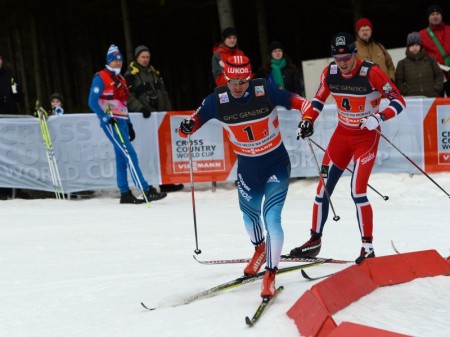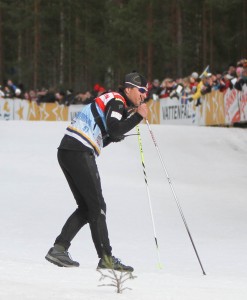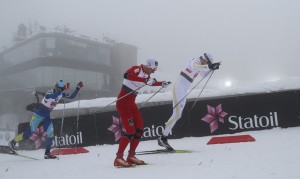
How much skate skiing should be allowed in a classic sprint race? Quite a bit, if Wednesday’s race in Drammen, Norway, was any indication. U.S. women’s coach Matt Whitcomb was well positioned to observe the technical shenanigans at play in Drammen.
“It was in the men’s qualifier race,” Whitcomb said. “I was actually standing on the corner where the infractions took place. There were at least eight skiers that were out of the tracks at the top of the course going around a left hand corner and really the only way to legally do it would have been to be in the tracks double poling. It was almost impossible not to skate. Our athletes and the more experienced Drammen skiers knew that they needed to be in the tracks, otherwise they’d be skating on a corner that was being controlled via technique monitors and jury members. It’s just not legit to be skating on a corner that has tracks.”
Ultimately the FIS jury decided to issue a written reprimand to 15 athletes. Two more athletes were disqualified as it was their second infraction for skating this season.
Michal Lamplot, a media director with FIS, wrote in an email to FasterSkier, “Both [Joeri] Kindschi (SUI) and [Siim] Sellis (EST) got the yellow card today for the classical technique violation. In their cases, it was the second yellow card, which means it led automatically to DSQ.”
“I was really disappointed by the call the jury made,” said Whitcomb of the decision to issue written reprimands instead of disqualification. “But that’s the call the jury makes, and I’m really supportive of that process. I was very certain that we would find out that Simi Hamilton would be in the heats after they made their decision. So we had Simi stick around and continue the cool down/warm up process before the heats.”

Hamilton finished 31st in qualifying, just one position and .23 seconds away from making the heats. In light of so many infractions, it seemed reasonable for Whitcomb to expect that Hamilton would be handed a starting lane in the quarterfinals.
“They ended up just giving written reprimands,” said a frustrated Whitcomb. “I don’t think it was the right call; I think classic skiing took a step backwards. I don’t think the line between what’s legitimate for classic technique was respected yesterday, and I think it opens a can of worms that makes the line very fuzzy now.”
“At least half a dozen athletes I would have disqualified. And I would say the same if it were our own athletes. We teach technique legally and we play by the rules. It’s not always that we’ll be in the right on certain technical matters because in sprint racing you have to push the limits to fight for survival, as was the case with Sadie [Bjornsen]. That’s an accident and we can own up to that. But it’s too bad they supported the skating.”
Vegard Ulvang, the head of the International Cross Country Committee for FIS and a Norwegian ski legend, sounded the alarm about the future of classic skiing after the men’s 15 k in Sochi. Ulvang is worried about what is called “alley skating” in Norway will take over the sport. “Alley skating” is when a skier frequently changes tracks, skating across the alley between classic tracks.
“Juries must be tougher,” said Ulvang to NRK. “It is allowed to change tracks, but when, as in the sprint in Asiago before Christmas, we see that a skier is switching tracks three times on the same slope, then we must begin to discuss it.”
“I’ve even seen races where it is quite obvious that many are skating,” said Ulvang. “They cheat! There is a problem.”
The skating on display in Drammen wasn’t quite “alley skating” by its typical definition. Skiers were skiing outside of the tracks as it was slightly faster, and taking skating strides to round the corner.
“During the World Championships in Lahti in 2001 there was so much skating in classic races that it was totally unacceptable,” recalled Ulvang. “We did not have enough rules. Afterwards we made the rule. I would argue that it’s the rock of classic cross country skiing: where there are set tracks, you are not allowed to take direction altering thereof.”

Ulvang is also concerned about the creeping prevalence of double poling classic races in their entirety. Exclusive double poling has long been a part of men’s sprint racing including Drammen, and flat long distance events such as the Marcialonga and Vasaloppet. Now, Ulvang sees a potential for skiers to use skate skis on all courses.
“We have seen examples of skiers who have [double poled] a 15 kilometer race. Johan Kjølstad double poled the extremely tough course in Beitostoelen and was number twenty in the national opening this season. It makes me worried,” said Ulvang, wondering, “What happens in five or ten years? I think we will soon see skiers double poling 15 km at the World Cup.”
Ulvang thinks that using skate skis in classic races is more practical now because the skiers are stronger, the glide is faster, and the poles are lighter and stronger, making double poling more effective than it was in the past.
Tor Arne Hetland, a former Norwegian sprint star and current Swiss National Team Coach, told NRK after the Drammen race that he didn’t believe Ulvang’s hype about classic skiing being corrupted. “I would say that there was much more skating during classic races in Ulvang’s time, in the late 80’s and 90’s. Then there was much less control. Now there is actually pretty good control,” said Hetland, coach of disqualified skier Joeri Kindschi.
Hetland also raised the point that the rules are not necessarily evenly enforced across all World Cup races. “There should be a more consistent interpretation of the rules,” Hetland suggested. “One must consider if the exact same jury should travel around to all the World Cups. Only then will there be identical decisions. It is important that the skiers know where the boundaries are.”
In Hetland’s eyes the rise of double poling classic races is a sign that the sport is developing further. “For me to watch the skiers go diagonal up a hill is one of the most beautiful things,” Hetland said. “But seeing two skiers in a double pole duel, such as that between Ola Vigen Hattestad and Pål Golberg here in Drammen is also beautiful. It certainly has its place in cross country skiing.”

Ulvang’s view on the matter has also changed. “I would say that it is not as important today as it once was,” he said of the separation of disciplines on the World Cup, an issue that Ulvang had been outspoken about. “It won’t be a disaster for the professional portion of the cross country sport if it just has skating.” But, Ulvang added, “It will be considerably worse for recreational skiing.”
Ulvang was referring to the steady increase in recreational skiers that choose to skate, causing him to worry that classic skiing might disappear as a way that the average skier chooses to ski. Ulvang is now more concerned with protecting the integrity of classic technique in the big traditional races such as the Vasaloppet, Marcialonga and the Birkebeinerrennet.
“That we want to have classic cross country has to do with tradition, culture, and history,” said Ulvang. “But above all, it’s the most natural movement for most of us when we go skiing.”
Though Hetland and Ulvang disagree about the impact that these techniques will have on the sport, both men agree on one thing: we will soon see skiers double poling 15 k races on the World Cup.
Pasha Kahn
Pasha Kahn writes and coaches in Duluth, Minnesota.

5 comments
jmeserve
March 8, 2014 at 10:34 am
The solution is simple, but it will never happen. Slow the sport down by making classic truly classical by reintroducing wooden skis, or at least wooden based skis to the classical discipline.
Martin Hall
March 8, 2014 at 1:44 pm
As I watched the other day—-I commented out loud that one of the skiers was skating ever so compressed on one of the straight stretches between the tracks—not a few strokes, but a lot—my wife asked if she had heard me correctly—I said yes, the skier was cheating. So, yes there was a lot of skating—-but, I am not in agreement with Matt, it is the or are the Juries reluctance to disqualify the skiers that is hurting the sport right now, Whether it is skating or interference the juries have been very delinquent in dealing with these infractions over the past month(yes, Olympics too)—paper penalties are what they are handing out—what is that—the skiers laugh. As Vegard said—it is time for the FIS to direct this with stronger action. A professional jury is necessary as is more video recording and replay—like other professional sports. Our sport lends itself well to cheating—-for barging, interference, skating, broken equipment etc—-the athletes are racing for good prize money—take some of it away from them.
On double poling and skating taking over the sport—it becomes critical for the course designers to make sure they do everything they can, to at some point design those technique modifiers into the course—-whether they are natural or artificial. This may be in the future impossible to do—as the skiers just continue to train the diagonal stride out of the sport.
FIS has always been reluctant to use the disqualification card as it casts doubt on the integrity of the event, the sport and FIS the organizing body.
In 1983 in the pre-Olympic event in Sarajevo, we had one of the most ugliest days of classical race in the history of the sport–wet snow, snow falling off trees in big clumps and landing in the tracks–coaches were waxing skis on the course and giving them to the racers, coaches scrapping skis, athletes changing skis, athletes finishing with one and two unmarked skis—-not one disqualification was handed out—yes, warnings. The same old deal.
This is getting ugly—-I can liken it to the drug problem that has turned xc skiing into a real fiasco and it didn’t have to be if FIS had taken clear and final action right from the start—with a huge emphasis on the word FINAL—kick the cheaters out for life.
FIS is a very slow moving organization and marginal on running its self like a business!!!
Answers are out there—lets stop the cheating.
davord
March 8, 2014 at 9:29 pm
Marty, if they kicked the cheaters out for life, at least half of them would be gone. A lot of star players would be out. FIS, like many big corporations (yes, it is a corporation) and sports leagues (MLB, NFL, UCI, IAAF) can’t afford to lose their stars, otherwise they lose sponsorships, TV deals, money and fans. Modern sport is all about money, hence so much investment in big stars. We’ll see how ballsy Swedish TV is and how far they take their history of doping in nordic skiing documentary and if they bring out names that should have already been busted.
In regards to skating, I would say to have everyone ski with classic equipment for classic races. That will clear out at least a part of the problem. Panzhinskiy (#1 qualifier, U23 world champion, World Junior champion, 2010 Olympic silver medalist, 2011 WSC bronze medalist) was DQ’d in the first heat for ‘skating’ after making the semis. Honestly, I didn’t see anything wrong in his heat and many were doing blatant skating and yet they were not penalized. He wasn’t even warned, he was relegated to last. Perhaps he had already had a yellow card from earlier in the year, but still…
Martin Hall
March 9, 2014 at 11:52 pm
Davord–my point is go to a life time sanction and the doping will stop faster then you can snap your fingers—just do it and the drugged pipe line will dry up—I’ll bet it won’t take very many skiers who are gone—and then the tracks will be full of clean skiers.
Then every one doesn’t have to worry about embarrassing themselves. FIS etc, etc
paldesgn
March 10, 2014 at 12:08 pm
Unless we turn classic sprints into 1.5 km hill climbs, we’re going to see more and more questionable skate moves in these events. The extra skate (or two) around a corner, the constant switching of lanes, the half-marathon skate, etc. are all standard sprint techniques used to quickly gain a spot. Almost every skier does this in the classic sprints. It’s almost ridiculous to even call these events “classic sprints.” I think we now are at a point where sprint racing should be exclusively freestyle—they are events of power and speed and there are way too many classic technique gray areas. Removing the classic designation simplifies the racing and allows the fastest skier win.